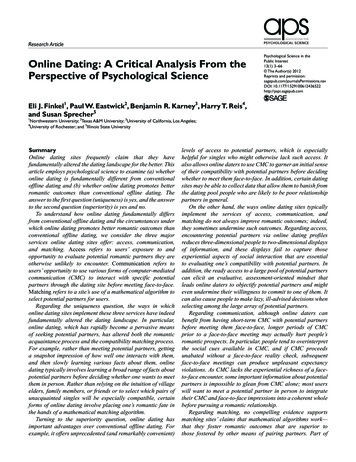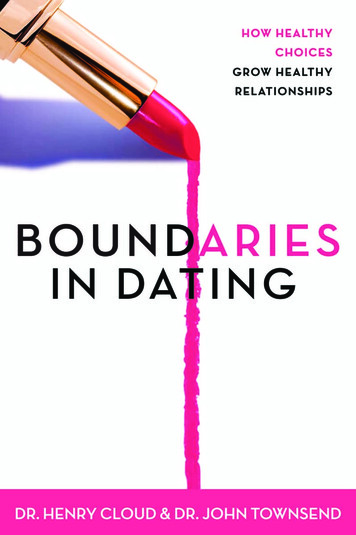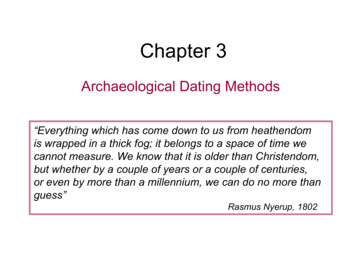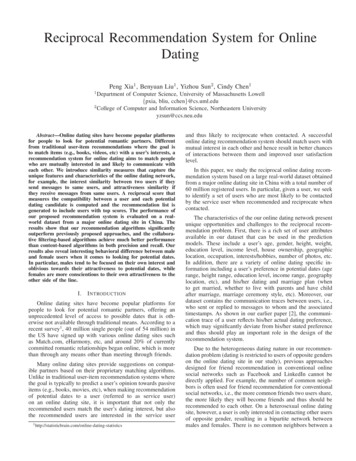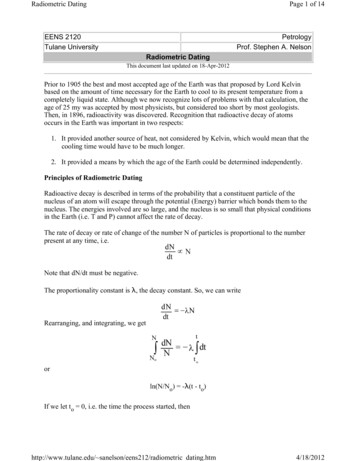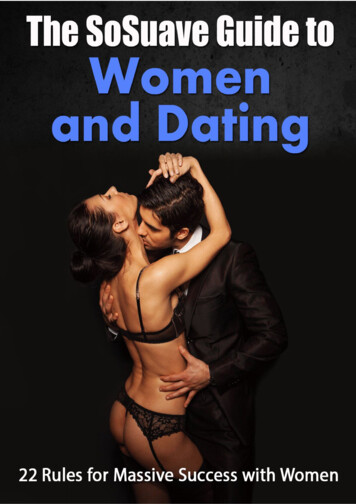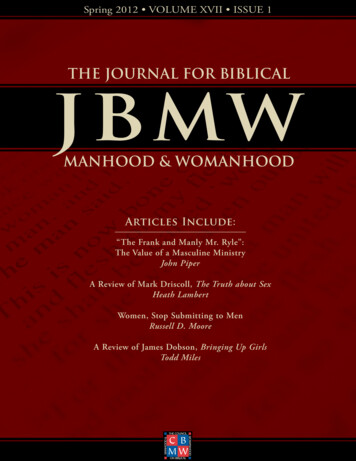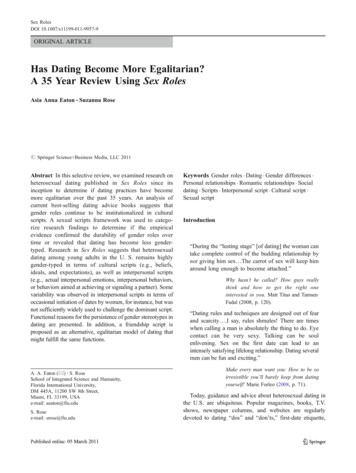
Transcription
Sex RolesDOI 10.1007/s11199-011-9957-9ORIGINAL ARTICLEHas Dating Become More Egalitarian?A 35 Year Review Using Sex RolesAsia Anna Eaton & Suzanna Rose# Springer Science Business Media, LLC 2011Abstract In this selective review, we examined research onheterosexual dating published in Sex Roles since itsinception to determine if dating practices have becomemore egalitarian over the past 35 years. An analysis ofcurrent best-selling dating advice books suggests thatgender roles continue to be institutionalized in culturalscripts. A sexual scripts framework was used to categorize research findings to determine if the empiricalevidence confirmed the durability of gender roles overtime or revealed that dating has become less gendertyped. Research in Sex Roles suggests that heterosexualdating among young adults in the U. S. remains highlygender-typed in terms of cultural scripts (e.g., beliefs,ideals, and expectations), as well as interpersonal scripts(e.g., actual interpersonal emotions, interpersonal behaviors,or behaviors aimed at achieving or signaling a partner). Somevariability was observed in interpersonal scripts in terms ofoccasional initiation of dates by women, for instance, but wasnot sufficiently widely used to challenge the dominant script.Functional reasons for the persistence of gender stereotypes indating are presented. In addition, a friendship script isproposed as an alternative, egalitarian model of dating thatmight fulfill the same functions.A. A. Eaton (*) : S. RoseSchool of Integrated Science and Humanity,Florida International University,DM 445A, 11200 SW 8th Street,Miami, FL 33199, USAe-mail: aeaton@fiu.eduS. Rosee-mail: srose@fiu.eduKeywords Gender roles . Dating . Gender differences .Personal relationships . Romantic relationships . Socialdating . Scripts . Interpersonal script . Cultural script .Sexual scriptIntroduction“During the “lusting stage” [of dating] the woman cantake complete control of the budding relationship bynot giving him sex The carrot of sex will keep himaround long enough to become attached.”Why hasn’t he called? How guys reallythink and how to get the right oneinterested in you. Matt Titus and TamsenFadal (2008, p. 120).“Dating rules and techniques are designed out of fearand scarcity .I say, rules shmules! There are timeswhen calling a man is absolutely the thing to do. Eyecontact can be very sexy. Talking can be soulenlivening. Sex on the first date can lead to anintensely satisfying lifelong relationship. Dating severalmen can be fun and exciting.”Make every man want you: How to be soirresistible you’ll barely keep from datingyourself! Marie Forleo (2008, p. 71).Today, guidance and advice about heterosexual dating inthe U.S. are ubiquitous. Popular magazines, books, T.V.shows, newspaper columns, and websites are regularlydevoted to dating “dos” and “don’ts,” first-date etiquette,
Sex Rolesand strategies to succeed with the opposite gender. In part,this is surely due to the general importance of socialconnectedness for human well-being (for a review seeCacioppo and Patrick 2008). It may also reflect theidolization of romantic relationships in American culture(for a review see Galician 2004), where romance novelshave long been the most popular genre in literature (Regis2003) and single people are pitied and stereotyped aslacking the most important source of happiness (e.g., Cateand Lloyd 1992; DePaulo 2006). Still, this glut of datingadvice may also be the consequence of changing datingpractices and the resulting conflict between tenacious oldnorms and preferences and emerging new ones, especiallywith regard to gender prescriptions.The quotes at the beginning of this paper are examplesof the mixed messages about gender and dating that occurin popular culture. But to what extent has U.S. culture trulyabandoned the traditional norms of female passivity andmale agency in early dating practices? To what extent haveindividual men and women embraced egalitarian practicesin actual early romantic encounters? In this paper, we useresearch from the journal Sex Roles to examine the natureof dating today and to determine whether the current datingnorms and practices of young people have progressedtoward an egalitarian feminist ideal.Since the inception of the journal Sex Roles 35 yearsago, women have made substantial progress in gainingpower and authority in the public sphere. Because of thisprogress, modern concepts and behaviors in dating may beless about male power than they were when Sex Roles wasfounded. For example, the male-to-female pay gap in the U.S. for full-time workers has been narrowing over the past30 years (Bureau of Labor Statistics 2009). On the otherhand, there is abundant evidence that gender stereotypesremain as strong in the modern collective conscious as theywere in the 1970s (e.g., Bergen and Williams 1991; for areview see Wood and Eagly 2010). A careful examinationof all empirical research on dating published in Sex Roleswill illuminate which of these realities is most true in therealm of early romantic encounters.In this review, the journal Sex Roles was used as thebasis for our analysis in honor of its 35 years of publishingand because of its reputation as one of the premier forumsfor feminist psychology research, established with theexplicit aim of identifying the processes and consequencesof gendered stereotypes and behaviors (Chrisler 2010). Ifthere has been a cultural or interpersonal shift in the lastseveral decades in the extent to which beliefs or behaviorsabout dating are gender-typed, we can expect that Sex Roleswill have captured it.From a feminist perspective, we see dating as a primearena for evaluating progress towards gender equality. First,dating is a historically-gendered part of heterosexualromantic relationships that supports men’s power andgender stereotypes (e.g., Belsey 1994; Impett and Peplau2003; Mahoney and Knudson-Martin 2009; Sprecher andMcKinney 1993; Winstead et al. 1997). Secondly, datesrepresent important “turning points” where a relationshipmight move from platonic to romantic (Morr and Mongeau2004). The preferences and behaviors expressed in earlydating may, intentionally or unintentionally, “set the stage”for the entire course of the relationship. If gender roles andnorms are used to stabilize and structure early relationshipinteractions they may establish a trajectory for futureinteractions that contributes to the perpetuation of genderstereotypes and gender-differentiated behavior. Finally,initial romantic encounters, especially first dates, are knownas being vehicles for uncertainty reduction (Afifi and Lucas2008). However, to the extent that gender is used as thebackdrop for this process, gender-inconsistent informationabout one’s partner or oneself may not be revealed,reducing the likelihood of finding a compatible partnerand yet again contributing to the perpetuation of culturalstereotypes about men and women.What Is Dating?Broadly defined, dating is a publicly-expressed practiceundertaken by romantically-interested partners for thepurpose of getting to know one another better (e.g., Bailey1988; Bogle 2008; Diamond et al. 1999). The practice ofdating has a long and vibrant history in the U.S., going backabout a century (e.g., Bailey 1988). Like many modern socialcustoms, dating has its origins in the post-Industrial revolution. At that time, the sheltered courtship practice of “calling”was closely monitored by the family and community, andtook place in the bachelorette’s home (Rothman 1984).However, courtship encounters were soon mobilized byaverage citizens’ increased access to automobiles andwomen’s increasing role in the public sphere. These changesmoved courtship from the home to public locations, such asmovie theaters, dance halls, and restaurants. By the mid1920s, going on “dates” had become a “universal custom” foryoung men and women in the U.S. and the dominant scriptfor romantic interactions between singles (Bailey 1988).Although dating is more recreational than the courtshippractices that preceded it, dating is also viewed as a processof narrowing the field of suitable marriage partners (Whyte1990), and can be understood as a prelude to courtship,which is a prelude to marriage (Laws and Schwartz 1977).Because society is so invested in the outcomes of courtshippractices (i.e., marriage and the family system), andbecause dating is a largely public act, it has always comewith a host of prescribed rules and expectations (e.g.,Gilligan 1982; Ginsburg 1988). The stereotypes about the
Sex Rolesevents and actions associated with and appropriate for “adate” are called dating scripts or schemas (Ginsburg 1988).Like all scripts, dating scripts are cognitive representationsthat include information about the standard and desirablesequence of events and behaviors for a particular situation(Abelson 1981). These scripts are used to organize,interpret, and predict the behavior of individuals in datingencounters, and they exist at both a cultural and interpersonallevel (Simon and Gagnon 1986).Cultural scripts are “collective guides” for situationalnorms, values, and practices that are characteristic ofand accessible to cultural insiders (e.g., Goddard andWierzbicka 2004; Klinkenberg and Rose 1994; Triandiset al. 1984). Interpersonal scripts, on the other hand, arethe behavioral enactment of a specific cultural script by anindividual (Simon and Gagnon 1986). Interpersonalscripts are more detailed and subjective than cultural scripts,and incorporate personal preferences and knowledge(Klinkenberg and Rose 1994).Dating advice books provide one non-empirical sourceof popular cultural scripts for gender roles in dating. Aprevious examination of dating advice books from the late1980s indicated that dating etiquette was highly gendertyped (Rose and Frieze 1989). Men were expected toinitiate, plan, and pay for dates and to initiate sexualcontact, whereas women were supposed to be alluring,facilitate the conversation, and limit sexual activity.Cultural norms as expressed in dating advice books in2010 suggest that gender roles in dating have not changedmuch over the past two decades. We surveyed sevenpopular books published in the last 5 years that focusedon general dating advice for heterosexual adults. In linewith the Rose and Frieze’s 1989 examination of datingguides, we were specifically concerned with prescriptionsfor which partner should initiate the date, pay for the date,and engage in or reject physical contact during the date.Three of the selections were among the top five best-sellingbooks in the category of “dating advice” at Amazon.com, apremier online bookseller searched on July 25th, 2010(Browne 2006; Forleo 2008; Miller 2004). The other fourbooks were among the top 100 best-sellers and werewritten by well-known authors (e.g., Dr. Phil) and expertmatchmakers.Overall, this select set of current popular books generallyendorsed traditional feminine passivity and masculineagency in the dating context. Four of the advice manualswere dependably gender-typed (Titus and Fadal 2008;Casey 2009; Miller 2004; McGraw 2005) (see Table 1).Those aimed at women included whole chapters on usingindirect influence and passive strategies in dating, such asthe chapter “Getting Him to Ask You Out” (Titus and Fadal2008); reminded women to indirectly manage their relationship from behind the scenes, given that men “need tofeel like the leader in relationships” (McGraw 2005, p.124); or advised women in multiple chapters about how tobeautify or treat various body parts, e.g., “Nipples,Lingerie, and Hosiery” and “The Vagina” (Casey 2009).In the one book designed for single men, they were advisedto act like the “natural born aggressor[s]” that they are and totake control of the dating environment (Miller 2004, p. 30).The remaining three books allowed for some genderflexibility in terms of initiating a date, stating that it wasacceptable for a woman to ask for a date or encouragingwomen to try it (Browne 2006; Spindel 2007; Forleo 2008).However, most of the advice was consistent with genderstereotypes. For instance, women who asked for a date weretold to take into consideration that the man might think theywere “hot to trot” (Browne 2006, p. 91) and were advised“don’t object to his plans unless you really have to” (Spindel2007, p. 43). In summary, current cultural norms for genderroles in dating as expressed in this genre of popular culturewere highly gender-typed.In contrast, some research has shown that dating patternshave changed in the past 35 years. Dating is no longer thedirect path to marriage that it once was (Libby 1976), nor isdating the only, or even primary, type of initial romanticencounter young singles engage in today (e.g., Bailey 1988;Paul and Hayes 2002). Some research suggests that theculture of courtship has given way to a hook up cultureamong college coeds (Bogle 2008), where dates are rareand carry multiple meanings (Glenn and Marquardt 2001).A hook up was defined as “a sexual encounter which mayor may not include sexual intercourse, usually occurringbetween people who are strangers or brief acquaintances”(Paul et al. 2000, p. 76). The gender dynamics associatedwith hook ups do not appear much different from those indating, however. In hook ups, women lose status andexperience more regret and guilt than men (Crawford andPopp 2003; Eshbaugh and Gute 2008). Many youngpeople today also go on “group dates,” in which ahandful of young men and women meet at commongathering places for the purpose of having fun with thepotential for dyadic relationship initiation (e.g., Bredowet al. 2008), and engage in the practice of speed dating (e.g.,Finkel et al. 2007).Does the addition of these new forms of dating representa move towards gender equality in early romantic relationships in the U.S.? Or does the empirical evidence indicatethat dating beliefs and behaviors continue to be highlystereotypic in terms of gender? We address this questionusing research in the journal Sex Roles, offer an explanationfor the tenacity of gender-typing in initial romantic encounterscripts based on research on interpersonal relationshipdevelopment, and suggest an alternative egalitarian modelthat could be successfully adapted to suit the “getting to knowyou” stage in heterosexual relationships.
2005 Dr. Phil McGraw (m)“Love Smart: Find theOne You Want- Fixthe One You Got”“ there is a very fine line between getting him to askyou out and asking him out yourself. We don’t wantyou to do the latter. The man should still bethe aggressor” (p. 101)Women are advised to “get him to ask you out”and to take control of the relationshipby rejecting physical contact and sex.Women are told men need to feel in chargeand men are intimidated by strong women.It is insinuated that the male will approachthe woman to ask for the date (p.167)WomenWomen2006 Dr. Joy Browne (w)2007 Janis Spindel (w)2008 Marie Forleo (w)“How to date men: Dating Secretsfrom America’s Top Matchmaker”Make every man want you:How to be so irresistible you’llbarely keep from dating yourself!(#2 on Amazon.com bestseller’s list, July 2010)Either person may ask for date but it is idealfor the man to ask. The man is portrayedas wanting to pay for the date and the womanis advised to allow him. Women should voicetheir preferences except when it interfereswith the man’s agenda or role.Who asks for the date, pays for the date, andinitiates or rejects physical contact dependson the situation. Women are advised to usetheir “most powerful tool-your intuition-toguide you on a case-by-case basis.” (p.137)“Dating rules and techniques are designed out of fearand scarcity. .There are times when calling a manis absolutely the thing to do Sex on the first datecan lead to an intensely satisfying lifelong relationship.Dating several men can be fun and exciting” (p. 69)“Don’t object to his plans unless you really have to” (p. 43),followed later by “be decisive. Men don’t like it whenthey have to make every decision for you.” (p. 64)“Not only does he want to pay, but it’s awkward foryou to make this half-hearted attempt to split the bill.” (p. 74)“Women, if you’ve never asked a guy out, you should do it for yourown liberal education. Guys love it. However, they may think you’rehotter to trot (sexually) than you really are, so take that intoconsideration.” (p. 91)“If you can’t afford a few dinners out and a bouquet of flowers fromtime to time, you might as well hang it up now.” “If they [women]know that you’re willing to spend a little on them, more than likely,they’ll give you a chance to do a little in the bedroom.” (p. 36)“Do not ever let her pay for anything!” (p. 38)“Men need to feel like the leader in relationships Right or wrong,women seem to fare pretty well when they manage their relationshipswith men in a way that allows the man to think that decisions such aswhether to make a commitment or not are totally his idea.” (p. 124)Women are advised about appearance in multiple “A woman’s vagina is an area of her body that, when itcomes to men, has very little wiggle room for mistakes.chapters, including chapters on “Nipples,Men have an incredibly specific vision and expectation of whatLingerie, and Hoisery,” “Body Odor andshould be going on down there it is important to focus onBad Breath,” and “The Vagina,” etc.some of the flaws men find here so that you feel completelyWomen are advised to reject sex (p. 181)comfortable with your experience.” (p. 37)Relevant quotesGeneral adviceMen are told that women are “picky” and “playhard to get” (p. 29) because of their largerinvestment in the outcomes of mating. Menare “natural born aggressor[s]” fromthe “hunting and gathering days” (p. 30)and need to approach women fordates and pay for dates.Both men and women Either person may ask for date, the onewho asks should pay for date, eithermay initiate or reject physical contact.MenWomen“Dating for Dummies”(#5 on Amazon.com bestseller’s list, July 2010)“Understanding Women:2004 Romy Miller (w)The Definitive Guide toMeeting, Dating and Dumping,if Necessary” (#1 on Amazon.combest seller’s list, July 2010)2009 Whitney Casey (w)“The Man Plan”Women2008 Matt Titus (m) & Tamsen Fadal (w) WomenTarget“Why Hasn’t He Called?:How Guys Really Thinkand How to Get the RightOne Interested in You”Authors (gender)YearTitleTable 1 Gender roles in contemporary dating and relationship advice self-help booksSex Roles
Sex RolesDating Research in Sex RolesDating research within the journal Sex Roles was identifiedthrough the PsychInfo database using a search for any ofthe following keywords: “date,” “dating,” “courtship,” or“hookup.” The “keyword” search option in PsycInfosearches the title, abstract, and descriptors of all entries inthe database for the target keyword. One hundred and fortythree works were identified, ranging in publication datefrom January 1978 to December 2010, including four 2010advance online publications. Twenty-three were removedbecause they applied to non-U.S. samples. In addition, 26works were withdrawn because they were reviews, bookreviews, duplicates, references to temporal dating, misclassified as pertaining to dating, or errata. The remaining 94articles were sorted by decade: the 1980s (N 20), 1990s(N 28), and 2000s (N 46). The vast majority of thearticles focused on young adults, typically college students.Research within each decade was further classified andsummarized in terms of whether it assessed aspects ofcultural scripts (e.g., beliefs, concepts, ideals, responses tohypothetical situations) or interpersonal scripts (i.e., participants’ behaviors in actual dating situations). This comparisonillustrated the extent of the congruence between cultural scriptsand interpersonal behavior.Dating Research in Sex Roles, 1980–1989One of the central themes in dating research in Sex Rolesfrom the 1980s was the effect of gender identity andtypicality on dating attitudes and behaviors. For instance,the first empirical article on dating in Sex Roles waspublished in 1982 by Orlofsky, who examined therelationship between participants’ gender identity andideology and their preferences for gender-typed mates.Additional research examined the balance and bases ofpower in dating relationships for men and women (e.g.,Grauerholz 1987; Sprecher 1985) and gender identity andrape acceptance (e.g., Bridges and McGrail 1989). Thesearticles followed the growing trend in feminist psychological research at the time to uncover and understandgender identity and schematicity and gender differences insocial behavior.Cultural ScriptsFourteen of the 20 articles on dating (70%) from 1980 to 1989assessed some aspect of cultural scripts, such as ideals, beliefs,attitudes, and responses to hypothetical situations. An analysisof these findings revealed that heterosexual dating relationships in 1980s America were characterized by highlytraditional cultural script elements, including gender-typedpartner preferences, beliefs, and attributions.In terms of interpersonal attraction, both women andmen rated an ideal woman as thinner (i.e., more underweight) than an ideal man (Stake and Lauer 1987). Menwere found to be more concerned with the physicalcharacteristics of potential partners and women were moreconcerned with psychological and personal qualities of apotential partner, such as achievement and intelligence (e.g.,Deaux and Hanna 1984; Nevid 1984). Even women and menwith nontraditional (egalitarian) gender role attitudesdescribed an “ideal dating partner” as having stereotypicallygender-typed personality traits (Orlofsky 1982).Gender-typed responses also were found in preferencesfor opening lines, dating jealousy, attitudes towards extradyadic relationships, and acceptance of cross-status relationships. Women preferred that men use innocuousopening lines when meeting a woman (e.g., “Are you astudent?”) or direct ones (e.g., “I’m sort of shy, but I’d liketo get to know you”). However, men preferred cute-flippantlines such as, “Isn’t it cold? Let’s make some body heat”(Kleinke et al. 1986). Hansen (1985) reported that amajority of both women and men expected dating partnersto end close cross-gender friendships and that womencollege students reacted with more jealousy than men tohypothetical situations involving a dating partner spendingtime on a hobby or with family members. Furthermore,gender role traditional women and men expressed morejealousy than less traditional participants in response to allthe scenarios (Hansen 1985). In response to hypothetical“jealousy-producing” vignettes, Margolin (1989) reportedthat young men were more accepting of a man having anoutside sexual relationship in dating relationships than inmarriage; women did not approve of extra-dyadic activitiesin either dating or marriage. Adams (1984) investigatedattitudes towards dating among cadets at West Point duringthe first 3 years that coeducation was implemented andfound that women cadets were more approving than men ofdating across cadet ranks rather than restricting dating tothose within the same rank. Women also were moreaccepting of dating in general.Power strategies in sexual encounters were gender-typedboth in terms of concepts and behavior. McCormick et al.(1984) presented twenty descriptions of strategies forinfluencing a date to have or to avoid sex to collegestudents and asked the probable gender of a person whowould use such an approach. Participants stereotyped allstrategies for having sex as being initiated more often bymen and all strategies for avoiding sex as being initiatedmore often by women. The authors concluded that thisscript had not changed from normative expectationsreported in the 1950s (cf. Ehrmann 1959) showing thatmen had positive control in a sexual encounter (usingavailable strategies to initiate sex) and women had negativecontrol (using strategies to avoid having sex). Finally,
Sex RolesLaner (1989) found that both genders perceive theirpartners as behaving competitively toward them, althoughboth prefer romantic partners who behave cooperatively(e.g., who are “nondefensive,” “sharing,” “helpful,”“empathetic”).Lastly, research investigated the relationship betweenrape acceptance and gender-based variables. Results indicated that both women and men held a woman moreresponsible for a hypothetical rape that was perpetrated by asteady dating partner than by a stranger (Bridges andMcGrail 1989); those with highly traditional attitudestowards women were less rejecting of date rape (Fischer1987); and men were more supportive of a man’s right toviolate a woman’s resistance to kiss or have sex than werewomen (Margolin et al. 1989). Women more often thanmen were found to define “milder” forms of behavior suchas gender-stereotyped jokes as being sexually harassing(Kenig and Ryan 1986).In sum, cultural scripts for dating in the 1980s werestrongly influenced by gender stereotypes, in terms of menand women’s partner preferences, men and women’s beliefsabout date rape, and stereotypes about men and women’sattitudes towards sex.Interpersonal ScriptsNine of the 20 articles (45%) from the 1980s providedresults based on actual behavior indicating that interpersonal as well as cultural scripts followed gender-typicalpatterns. Three of the articles studied aspects of bothhypothetical and actual dates and were also cited in theprevious section (Deaux and Hanna 1984; Stake and Lauer1987; McCormick et al. 1984), thus percentages do not addto 100% by decade due to overlap.For instance, in terms of ideal characteristics of a partner,Stake and Lauer’s (1987) research described above confirmed that the “thin” ideal for women was borne out inactual relationships as being more desirable. Twice as manyaverage weight women were presently dating and datedmore often. Overweight women more often than averageweight women were criticized by parents, peers, and matesconcerning their weight. Ethnically identified MexicanAmerican women expected that Mexican American menwould prefer less achieving women as potential partners(Gonzalez 1988). Gender differences also were observed ina content analysis of 800 personal advertisements ofheterosexual and homosexual advertisers from east- andwest-coast newspapers (Deaux and Hanna 1984). Menmore often mentioned physical characteristics and womenmore often emphasized psychological factors in their ads,regardless of sexual orientation.Power in dating was the focus of several studies in the1980s. For instance, Sprecher (1985) found that women’spower in actual dating relationships was based in controlover the reciprocation of love in the relationship. Incontrast, men were found to derive power from theperception that they had access to alternative partners.Interestingly, despite these differences in sources of power,men and women perceived themselves as equally powerfulin their relationships. The McCormick et al. (1984) studyon the use of power techniques in hypothetical situationsthat was discussed earlier also assessed actual behaviorusing self-reports. Both women and men indicated thatwomen used power strategies to avoid having sex and menused them to facilitate having sex. This suggests thatcultural and interpersonal scripts were congruent in terms ofpower strategies in dating.Undergraduates studied by Grauerholz (1987) providedadditional insight into power in dating. Relative power wasmost gender-typed in actual relationships for decisionsconcerning who had more influence (themselves or othercurrent partners) in terms of who would pay for a date, whowould pay for dinner when they go out, how often to goout, and whether to have sex or not. However, participantsthat were highly trusting, committed, or dependent perceivedtheir relationships to be egalitarian. These findings point to thedifficulty in assessing inequality in actual relationshipsbecause a number of factors may disguise or counteractinequality between heterosexual partners.Gender differences also were dominant in a longitudinalstudy of dating couples by Stephen and Harrison (1985).Most participants (81% of women and 76% of men) wereclassified as having “sex-typical” orientations to intimacy,in which the man is romantic and outer-directed and thewoman is sensual and inner-directed. However, “non-sextypical” couples and couples with one non-sex-typicalmember were found to have more satisfying and committedrelationships over a six-month period than sex-typicalcouples.The relationship between gender identity and datingbehavior was explored by DeLucia (1987) using the BemSex Role Inventory and an index of dating behaviorsderived from self-reports of undergraduates’ dating experiences. Specific masculine behaviors included: “opensdoor for the other,” “pays for activities you do together,”and “expresses sexual preferences.” Feminine behaviorsincluded: “senses the other is disturbed about something,”“supports the other in decisions,” and “waits for the otherto initiate sex.” Strong gender differences in the use ofmasculine and feminine-typed behaviors were foundoverall, but the differences were less pronounced forcross-gender typed or undifferentiated individuals. Feminist identity was found to affect dating behavior as well(Rickard 1989). Women at the “passive-acceptance” levelof feminist identity development (the first stage ofdevelopment which includes passive acceptance of tradi-
Sex Rolestional gender roles and the belief that traditional roles areadvantageous) engaged in more gender-typed datingbehaviors than those at more advanced levels of feministidentity development. Women at the “synthesis” level offeminism, the fourth of five levels in which an authenticand positive feminist identity is developed and men andwomen are considered and treated as individuals, engagedin the widest range of dating behaviors.In summary, research in Sex Roles from 1980 to 1989indicated strong empirical evidence for gender roles inmany aspects of both cultural and interpersonal scripts. Italso pointed to the
Dating advice books provide one non-empirical source of popular cultural scripts for gender roles in dating. A previous examination of dating advice books from the late 1980s indicated that dating etiquette was highly gender-typed (Rose and Frieze 1989). Men were expected to
